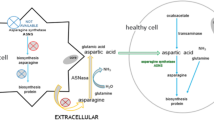Abstract
We show that a non–inhibitory monoclonal antibody (MAB) can be selected that provides substantial and sustained protection against proteolytic inactivation of L–aspar aginase by trypsin. Of six non–inhibitory, high affinity, monoclonal antibodies to L–asparaginase, one afforded approximately 70% protection. Inactivation of L–asparaginase is associated with a single cleavage adjacent to lysine–29 that results in loss of an N–terminal fragment with a calculated MW of 2,647. The protective MAB prevented this trypsin cleavage. The products of gene fusions of “humanized” fragments of such antibodies and L–asparaginase could have increased clinical utility.
Similar content being viewed by others
References
Shami, E.Y., Rothstein, A. and Ramjeesingh, M. 1989. Stabilization of biologically active proteins. Trends in Biotech. 7: 186–187.
Zyk, N. 1973. Modification of L-asparaginase EC-2 by homologous antibodies. Biochem. Biophys. Acta 302: 420–428.
Jemmerson, R. and Stigbrand, T. 1984. Monoclonal antibodies block trypsin cleavage site on human placental alkaline phosphatase. FEBS 173: 357–359.
Shami, Y., Rothstein, A. and Ramjeesingh, M. 1989. Use of antibody/antigen interactions to protect or modulate biological activity. European Patent Office Publication No. EP O 298 654 A2.
Shami, Y., Ramjeesingh, M., Rothstein, A. and Zywulko, M. 1991. Stabilization of enzymes by their specific antibodies. Enzyme Microb. Technol. 13: 424–429.
Broom, J.D. 1961. Evidence that the L-asparaginase activity of guinea pig serum is responsible for its antilymphoma effects. Nature 191: 1114–1115.
Maita, T., Morokuma, K. and Matsuda, G. 1974. Amino acid sequence of L-asparaglnase from E coli. J. Biochem. 76: 1351–1354.
Jenning, M. and Beacham, I. 1990. Analysis of the E coli gene encoding L-asparaginase II, ansB, and its regulation by cyclic AMP receptor and FNR proteins. J. Bacteriol 172: 1491–1498.
Peterson, R.G., Richards, F.F. and Handschumacher, R.E. 1977. Structure of peptide from active site region of E coli L-asparaginase. J. Biol. Chem. 252: 2072–2076.
Sheriff, S., Silverton, E.W., Paldan, E.A., Cohen, G.H., Smith-Gill, S.J., Finzel, B.C. and Davies, D.R. 1987. Three-dimensional structure of an antibody-antigen complex. Proc. Nail Acad. Sci. USA 84: 8075–8079.
Riechmann, L., Clark, M., Waldman, H. and Winter, G. 1988. Reshap ing human antibodies for therapy. Nature 332: 323–327.
Bird, R.E., Hardman, K.D., Jacobson, J.W., Johnson, S., Kaufman, B.N., Lee, S.M., Lee, T., Pope, S.H., Riordan, G.S. and Whitlow, M. Single-chain antigen binding proteins. Science 242: 423–426.
Kohier, G. and Milstein, G.C. 1975. Continuous cultures of fused cells secreting antibody of predefined specificity. Nature 256: 495–497.
Engvall, E. Enzyme immunoassay ELISA and EMIT. Meth. Enzymol. 70: 419–438.
Lefkovits, I. and Waldmann, H., 1979. Limiting Dilution Analysis of Cells in the Immune System, p. 60–82 Cambridge University Press, Cambridge, UK.
Jayaram, H.N., Cooney, D., Jayaram, S. and Rosenblum, L. 1974. A simple and rapid method for the estimation of L-asparaginase in chromatographic and electrophoretic effluents: comparison with other methods. Anal. Biochem. 59: 327–346.
Campbell, A.M. 1984. Monoclonal antibody technology, p. 209–211. In: Laboratory Techniques in Biochemistry and Molecular Biology Burdon, R. H. and Knippenberg, P. H. (Eds.) . Elesvier, Amsterdam.
Laemmli, U.K. 1970. Cleavage of structural proteins during the assembly of the head of the bacteriophage T4. Nature 227: 680–685.
Towbin, H., Staehelin, T. and Gordon, J. 1979. Electrophoretic transfer of proteins from polyacrylamide gels to nitrocellulose sheets: procedures and some applications. Proc. Nail. Acad. Sci. USA 76: 4350–4354.
Author information
Authors and Affiliations
Rights and permissions
About this article
Cite this article
Ramjeesingh, M., Zywulko, M., Rothstein, A. et al. Monoclonal Antibodies Can Protect L–Asparaginase Against Inactivation by Trypsin. Nat Biotechnol 10, 442–445 (1992). https://doi.org/10.1038/nbt0492-442
Received:
Accepted:
Issue Date:
DOI: https://doi.org/10.1038/nbt0492-442
- Springer Nature America, Inc.
This article is cited by
-
The negative influence of N-mediated TMV resistance on yield in tobacco: linkage drag versus pleiotropy
Theoretical and Applied Genetics (2007)




